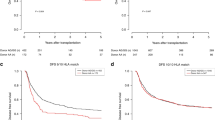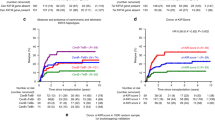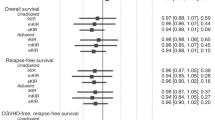Abstract
Interactions of polymorphic killer Ig-like receptor (KIR) receptors with KIR ligands have been shown to modify the outcome of hematopoietic SCT (HSCT). The association of these genetic factors with different transplantation endpoints, however, varies substantially, depending on clinical and study setup variables. We aimed to assess whether KIR ligands, KIR genes and KIR haplotypes are associated with HSCT outcome of 124 patients with various hematological malignancies, transplanted with 12/12 HLA matched grafts from unrelated donors. For this purpose, patient and donor KIR gene and KIR ligand polymorphisms were determined and correlated with clinical data in simple and multiple models. We found that a missing HLA-C2 ligand for donor inhibitory KIR2DL1 was significantly associated with an increased risk of acute GVHD (aGVHD) (II–IV) (hazard ratio (HR)=2.23, 95% confidence interval (95% CI): 1.21–4.10, P=0.010), as were the AA KIR haplotypes in patients and donors in HLA-C1CX (HR=2.37, 95% CI: 1.16–4.84, P=0.018) and in HLA-Bw4− (HR=3.20, 95% CI: 1.35–7.60, P=0.008) patients. On the contrary, transplantation of HLA-C1C2 patients with KIR2DS2 positive grafts were associated with a decreased risk of aGVHD (II–IV) (HR=0.24, 95% CI: 0.07–0.85, P=0.027). Thus, our single center study provides evidence for the modification of aGVHD risk by KIRs and their ligands.
This is a preview of subscription content, access via your institution
Access options
Subscribe to this journal
Receive 12 print issues and online access
$259.00 per year
only $21.58 per issue
Buy this article
- Purchase on Springer Link
- Instant access to full article PDF
Prices may be subject to local taxes which are calculated during checkout

Similar content being viewed by others
References
Uhrberg M, Valiante NM, Young NT, Lanier LL, Phillips JH, Parham P . The repertoire of killer cell Ig-like receptor and CD94:NKG2A receptors in T cells: clones sharing identical alpha beta TCR rearrangement express highly diverse killer cell Ig-like receptor patterns. J Immunol 2001; 166: 3923–3932.
Flores AC, Marcos CY, Paladino N, Capucchio M, Theiler G, Arruvito L et al. KIR genes polymorphism in Argentinean Caucasoid and Amerindian populations. Tissue Antigens 2007; 69: 568–576.
Hsu KC, Liu XR, Selvakumar A, Mickelson E, O’Reilly RJ, Dupont B . Killer Ig-like receptor haplotype analysis by gene content: evidence for genomic diversity with a minimum of six basic framework haplotypes, each with multiple subsets. J Immunol 2002; 169: 5118–5129.
Uhrberg M, Parham P, Wernet P . Definition of gene content for nine common group B haplotypes of the Caucasoid population: KIR haplotypes contain between seven and eleven KIR genes. Immunogenetics 2002; 54: 221–229.
Velickovic M, Velickovic Z, Dunckley H . Diversity of killer cell immunoglobulin-like receptor genes in Pacific Islands populations. Immunogenetics 2006; 58: 523–532.
Single RM, Martin MP, Gao X, Meyer D, Yeager M, Kidd JR et al. Global diversity and evidence for coevolution of KIR and HLA. Nat Genet 2007; 39: 1114–1119.
Parham P . MHC class I molecules and KIRs in human history, health and survival. Nat Rev Immunol 2005; 5: 201–214.
Karre K, Ljunggren HG, Piontek G, Kiessling R . Selective rejection of H-2-deficient lymphoma variants suggests alternative immune defence strategy. Nature 1986; 319: 675–678.
Ruggeri L, Capanni M, Urbani E, Perruccio K, Shlomchik WD, Tosti A et al. Effectiveness of donor natural killer cell alloreactivity in mismatched hematopoietic transplants. Science 2002; 295: 2097–2100.
Hsu KC, Keever-Taylor CA, Wilton A, Pinto C, Heller G, Arkun K et al. Improved outcome in HLA-identical sibling hematopoietic stem-cell transplantation for acute myelogenous leukemia predicted by KIR and HLA genotypes. Blood 2005; 105: 4878–4884.
Leung W, Handgretinger R, Iyengar R, Turner V, Holladay MS, Hale GA . Inhibitory KIR-HLA receptor-ligand mismatch in autologous haematopoietic stem cell transplantation for solid tumour and lymphoma. Br J Cancer 2007; 97: 539–542.
Witt CS, Christiansen FT . The relevance of natural killer cell human leucocyte antigen epitopes and killer cell immunoglobulin-like receptors in bone marrow transplantation. Vox Sang 2006; 90: 10–20.
Fischer JC, Ottinger H, Ferencik S, Sribar M, Punzel M, Beelen DW et al. Relevance of C1 and C2 epitopes for hemopoietic stem cell transplantation: role for sequential acquisition of HLA-C-specific inhibitory killer Ig-like receptor. J Immunol 2007; 178: 3918–3923.
Cook MA, Milligan DW, Fegan CD, Darbyshire PJ, Mahendra P, Craddock CF et al. The impact of donor KIR and patient HLA-C genotypes on outcome following HLA-identical sibling hematopoietic stem cell transplantation for myeloid leukemia. Blood 2004; 103: 1521–1526.
McQueen KL, Dorighi KM, Guethlein LA, Wong R, Sanjanwala B, Parham P . Donor-recipient combinations of group A and B KIR haplotypes and HLA class I ligand affect the outcome of HLA-matched, sibling donor hematopoietic cell transplantation. Hum Immunol 2007; 68: 309–323.
Verheyden S, Demanet C . NK cell receptors and their ligands in leukemia. Leukemia 2008; 22: 249–257.
Sullivan KM, Shulman HM, Storb R, Weiden PL, Witherspoon RP, McDonald GB et al. Chronic graft-versus-host disease in 52 patients: adverse natural course and successful treatment with combination immunosuppression. Blood 1981; 57: 267–276.
Rowlings PA, Przepiorka D, Klein JP, Gale RP, Passweg JR, Henslee-Downey PJ et al. IBMTR Severity Index for grading acute graft-versus-host disease: retrospective comparison with Glucksberg grade. Br J Haematol 1997; 97: 855–864.
Fischer GF, Fae I, Frey E, Mayr WR . HLA-A*02172* adds to the heterogeneity of HLA-A*02 alleles. Tissue Antigens 1998; 51: 312–314.
Du Z, Gjertson DW, Reed EF, Rajalingam R . Receptor-ligand analyses define minimal killer cell Ig-like receptor (KIR) in humans. Immunogenetics 2007; 59: 1–15.
Atkinson EJ, Therneau TM . An Introduction to Recursive Partitioning using the RPART Routines, vol. 61 Mayo Clinic: Rochester, 1997.
Breiman L, Friedman JH, Stone CJ, Olshen RA . Classification and Regression Trees, 1 edn. Chapman & Hall/CRC: London, 1984.
Fine JP, Gray RJ . A proportional hazards model for the subdistribution of competing risk. J Am Stat Assoc 1999; 94: 496–509.
Verheyden S, Schots R, Duquet W, Demanet C . A defined donor activating natural killer cell receptor genotype protects against leukemic relapse after related HLA-identical hematopoietic stem cell transplantation. Leukemia 2005; 19: 1446–1451.
Sobecks RM, Ball EJ, Maciejewski JP, Rybicki LA, Brown S, Kalaycio M et al. Survival of AML patients receiving HLA-matched sibling donor allogeneic bone marrow transplantation correlates with HLA-Cw ligand groups for killer immunoglobulin-like receptors. Bone Marrow Transplant 2007; 39: 417–424.
Miller JS, Cooley S, Parham P, Farag SS, Verneris MR, McQueen KL et al. Missing KIR ligands are associated with less relapse and increased graft-versus-host disease (GVHD) following unrelated donor allogeneic HCT. Blood 2007; 109: 5058–5061.
Chen C, Busson M, Rocha V, Appert ML, Lepage V, Dulphy N et al. Activating KIR genes are associated with CMV reactivation and survival after non-T-cell depleted HLA-identical sibling bone marrow transplantation for malignant disorders. Bone Marrow Transplant 2006; 38: 437–444.
Clausen J, Wolf D, Petzer AL, Gunsilius E, Schumacher P, Kircher B et al. Impact of natural killer cell dose and donor killer-cell immunoglobulin-like receptor (KIR) genotype on outcome following human leucocyte antigen-identical haematopoietic stem cell transplantation. Clin Exp Immunol 2007; 148: 520–528.
Gagne K, Brizard G, Gueglio B, Milpied N, Herry P, Bonneville F et al. Relevance of KIR gene polymorphisms in bone marrow transplantation outcome. Hum Immunol 2002; 63: 271–280.
Martin MP, Qi Y, Gao X, Yamada E, Martin JN, Pereyra F et al. Innate partnership of HLA-B and KIR3DL1 subtypes against HIV-1. Nat Genet 2007; 39: 733–740.
Cooley S, Trachtenberg E, Bergemann TL, Saeteurn K, Klein J, Le CT et al. Donors with group B KIR haplotypes improve relapse-free survival after unrelated hematopoietic cell transplantation for acute myelogenous leukemia. Blood 2009; e-pub ahead of print, 22 October 2008; doi:10.1182/blood-2008-07-171926.
Cooley S, McCullar V, Wangen R, Bergemann TL, Spellman S, Weisdorf DJ et al. KIR reconstitution is altered by T cells in the graft and correlates with clinical outcomes after unrelated donor transplantation. Blood 2005; 106: 4370–4376.
Sun JY, Dagis A, Gaidulis L, Miller MM, Rodriguez R, Parker P et al. Detrimental effect of natural killer cell alloreactivity in T-replete hematopoietic cell transplantation (HCT) for leukemia patients. Biol Blood Marrow Transplant 2007; 13: 197–205.
Vivier E, Tomasello E, Baratin M, Walzer T, Ugolini S . Functions of natural killer cells. Nat Immunol 2008; 9: 503–510.
Guerra N, Michel F, Gati A, Gaudin C, Mishal Z, Escudier B et al. Engagement of the inhibitory receptor CD158a interrupts TCR signaling, preventing dynamic membrane reorganization in CTL/tumor cell interaction. Blood 2002; 100: 2874–2881.
Ikeda H, Lethe B, Lehmann F, van Baren N, Baurain JF, de Smet C et al. Characterization of an antigen that is recognized on a melanoma showing partial HLA loss by CTL expressing an NK inhibitory receptor. Immunity 1997; 6: 199–208.
Junevik K, Werlenius O, Hasselblom S, Jacobsson S, Nilsson-Ehle H, Andersson PO . The expression of NK cell inhibitory receptors on cytotoxic T cells in B-cell chronic lymphocytic leukaemia (B-CLL). Ann Hematol 2007; 86: 89–94.
Poon K, Montamat-Sicotte D, Cumberbatch N, McMichael AJ, Callan MF . Expression of leukocyte immunoglobulin-like receptors and natural killer receptors on virus-specific CD8+ T cells during the evolution of Epstein-Barr virus-specific immune responses in vivo. Viral Immunol 2005; 18: 513–522.
Acknowledgements
We thank Dejan Stokic at the Complex System Research Group, ENT, Medical University of Vienna, for his help with the KIR genotype database. This work was supported in part by the European Commission Grant MCRTN-CT-2004-512253 (TRANSNET).
Author information
Authors and Affiliations
Corresponding author
Rights and permissions
About this article
Cite this article
Ludajic, K., Balavarca, Y., Bickeböller, H. et al. KIR genes and KIR ligands affect occurrence of acute GVHD after unrelated, 12/12 HLA matched, hematopoietic stem cell transplantation. Bone Marrow Transplant 44, 97–103 (2009). https://doi.org/10.1038/bmt.2008.432
Received:
Revised:
Accepted:
Published:
Issue Date:
DOI: https://doi.org/10.1038/bmt.2008.432
Keywords
This article is cited by
-
New approaches in graft versus host disease (GvHD) management
memo - Magazine of European Medical Oncology (2016)
-
A CT60G>A polymorphism in the CTLA-4 gene of the recipient may confer susceptibility to acute graft versus host disease after allogeneic hematopoietic stem cell transplantation
Immunogenetics (2015)
-
The beneficial impact of missing KIR ligands and absence of donor KIR2DS3 gene on outcome following unrelated hematopoietic SCT for myeloid leukemia in the Chinese population
Bone Marrow Transplantation (2010)
-
The impact of KIR2DS4 alleles and the expression of KIR in the development of acute GVHD after unrelated allogeneic hematopoietic SCT
Bone Marrow Transplantation (2010)
-
The role of killer immunoglobulin-like receptor haplotypes on the outcome of unrelated donor haematopoietic SCT for thalassaemia
Bone Marrow Transplantation (2010)



